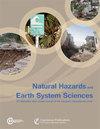评估意大利南部那不勒斯火山产生的长期辐射尘危害
IF 4.7
2区 地球科学
Q1 GEOSCIENCES, MULTIDISCIPLINARY
引用次数: 0
摘要
摘要目前,火山沉降危害建模与概率分析相结合,考虑了火山现象在喷发概率、喷发规模、喷口位置和气象条件等方面的自然变异性。在此框架下,我们提出了一种原型方法,用于在意大利南部开展来自那不勒斯活火山:索玛-维苏威火山、坎皮弗莱格雷火山和伊斯基亚火山的长期辐射尘危害评估。考虑到过去30年ECMWF ERA5气象数据集,FALL3D模型(v8.0)已被用于运行数千次数值模拟(每个喷发规模等级1500次)。基于贝叶斯程序,在大规模、高分辨率火山灾害评估的新工作流程中处理了关于地热负荷的输出,以便提供50年暴露时间内目标地点地面地热负荷超过给定临界阈值的平均年频率。我们的结果是用考虑不同聚集水平的绝对平均危险图来表示的,从每个火山源的影响和喷发规模等级到总危险的量化。这项工作首次提供了由火山灰沉降引起的多火山概率危害评估,可与用于地震现象和其他自然灾害的评估相媲美。这种方法可以应用于任何其他火山区域或不同的暴露时间,使研究人员能够解释目标火山的喷发历史,如果有的话,可能包括不太频繁的大喷发的发生,这是风险评估的关键因素。本文章由计算机程序翻译,如有差异,请以英文原文为准。
Assessing long-term tephra fallout hazard in southern Italy from Neapolitan volcanoes
Abstract. Nowadays, modeling of tephra fallout hazard is coupled with probabilistic analysis that takes into account the natural variability of the volcanic phenomena in terms of eruption probability, eruption sizes, vent position, and meteorological conditions. In this framework, we present a prototypal methodology to carry out the long-term tephra fallout hazard assessment in southern Italy from the active Neapolitan volcanoes: Somma–Vesuvius, Campi Flegrei, and Ischia. The FALL3D model (v.8.0) has been used to run thousands of numerical simulations (1500 per eruption size class), considering the ECMWF ERA5 meteorological dataset over the last 30 years. The output in terms of tephra ground load has been processed within a new workflow for large-scale, high-resolution volcanic hazard assessment, relying on a Bayesian procedure, in order to provide the mean annual frequency with which the tephra load at the ground exceeds given critical thresholds at a target site within a 50-year exposure time. Our results are expressed in terms of absolute mean hazard maps considering different levels of aggregation, from the impact of each volcanic source and eruption size class to the quantification of the total hazard. This work provides, for the first time, a multi-volcano probabilistic hazard assessment posed by tephra fallout, comparable with those used for seismic phenomena and other natural disasters. This methodology can be applied to any other volcanic areas or over different exposure times, allowing researchers to account for the eruptive history of the target volcanoes that, when available, could include the occurrence of less frequent large eruptions, representing critical elements for risk evaluations.
求助全文
通过发布文献求助,成功后即可免费获取论文全文。
去求助
来源期刊
CiteScore
7.60
自引率
6.50%
发文量
192
审稿时长
3.8 months
期刊介绍:
Natural Hazards and Earth System Sciences (NHESS) is an interdisciplinary and international journal dedicated to the public discussion and open-access publication of high-quality studies and original research on natural hazards and their consequences. Embracing a holistic Earth system science approach, NHESS serves a wide and diverse community of research scientists, practitioners, and decision makers concerned with detection of natural hazards, monitoring and modelling, vulnerability and risk assessment, and the design and implementation of mitigation and adaptation strategies, including economical, societal, and educational aspects.

 求助内容:
求助内容: 应助结果提醒方式:
应助结果提醒方式:


